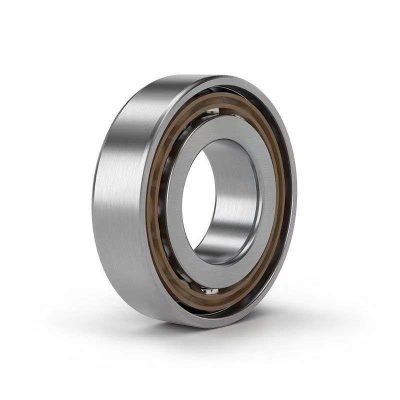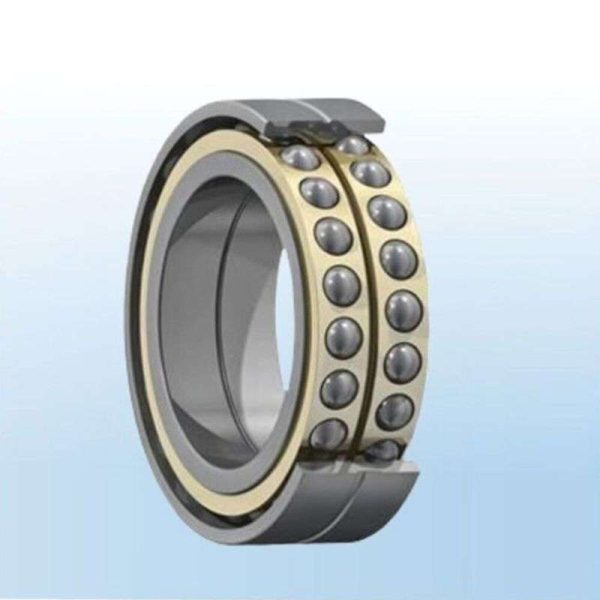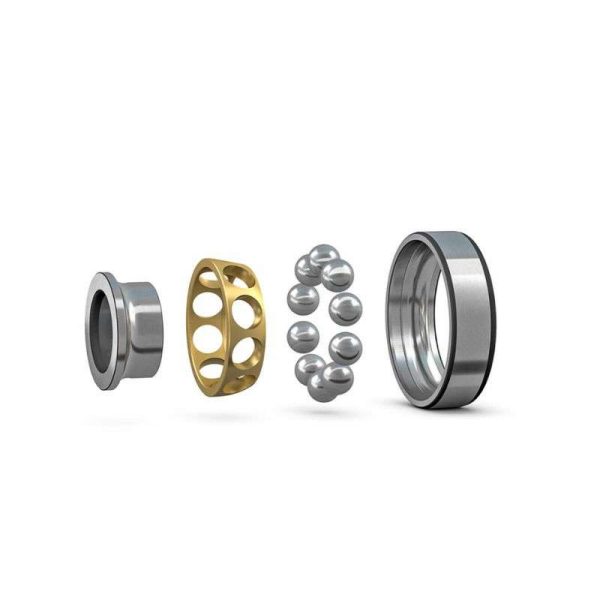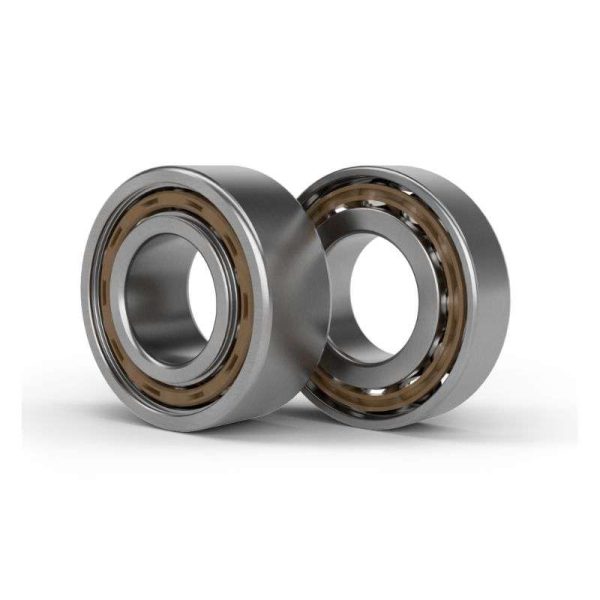Angular Contact Ball Bearings
Table of Contents
Categories
-
Adapter Sleeves (9)
-
Ball Bearings (11)
-
Ball Screw Bearings (2)
-
Ceramic Bearings (27)
-
Pillow Block Bearings (4)
-
Plain Bearings (32)
-
Roller Bearings (12)
-
Slewing Bearings (43)
-
Sliding Block (3)
-
Stainless Steel Bearings (27)
-
Super Precision Bearings (6)
-
Thin Section Bearings (9)
-
Track Rollers (4)
-
Universal Joints (1)
Definition of Angular Contact Ball Bearings
Angular contact ball bearings are rolling bearings designed so that the raceways between the inner and outer rings form an angle with the bearing axis. This design allows the bearing to withstand both radial and axial loads, as well as to perform well at high rotational speeds. Angular contact ball bearings usually consist of an inner ring, an outer ring, steel balls, a cage and seals, and their special angular design gives them high load capacity, high precision and good axial rigidity in mechanical systems. This makes angular contact ball bearings ideal for engineering applications requiring high performance and precision.

FHD Bearings is an ISO 9001:2015 certified manufacturing enterprise .Our company has a wide range of products in stock covering a wide range of areas to ensure that we are able to meet the diverse needs of our customers. We offer a wide selection of both models and specifications to ensure that our customers are able to quickly obtain the products they need and meet their specific engineering and business requirements.
Materials of Angular Contact Ball Bearings
-steel is one of the most common and widely used materials for angular contact bearings. It has good strength and wear resistance and is suitable for a wide range of industrial applications.
-FHD selects steel materials for their strength and abrasion resistance to ensure that the products perform well in a variety of industrial applications.
Stainless steel angular contact bearings have good corrosion resistance and are suitable for use in wet or corrosive environments, such as food processing, medical equipment and other fields.
-FHD uses stainless steel for industrial applications in wet or corrosive environments due to its excellent resistance to corrosion.
Ceramic angular contact bearings are usually made of ceramic materials such as silicon nitride (Si3N4) or aluminum oxide (Al2O3). They are characterized by low friction, high wear resistance and corrosion resistance and are suitable for high speeds, high temperatures and special environments.
-FHD’s use of ceramic materials is mainly based on their low friction, high wear and corrosion resistance properties for industrial applications at high speeds, high temperatures and in special environments.

Polytetrafluoroethylene(PTFE)
Polytetrafluoroethylene, such as PTFE, may be used in the seals and cages of angular contact bearings to provide good lubrication and anti-friction properties.
Alloy Steel
Alloy steels are usually used for some special applications with high strength and wear resistance for some applications that require extreme conditions of use.
Features of Angular Contact Ball Bearings

1.Bi-directional load bearing: able to withstand radial and axial loads at the same time, improving the bearing capacity.
2.High-speed rotation: Suitable for high-speed rotation working environment, excellent performance.
3.Accurate Positioning: Good positioning ability, suitable for systems requiring high precision position control.
4.High Rigidity: Provides strong axial rigidity in mechanical systems and reduces load-induced deformation.
5.Multi-functional applications: Widely used in machine tools, industrial robots, automotive drive systems and other fields.
6.High Wear Resistance: The use of wear-resistant materials improves the durability and life of bearings.
7.Low friction: Structural design and lubrication system reduces friction and improves efficiency.
8.Adapt to complex working conditions: able to cope with complex combined forces and loads in different directions.
9.Variety of materials: Different materials can be used, such as chrome steel, stainless steel, ceramics, etc., to adapt to different working environments.
10.Customizability: Diversified models and specifications are available to meet the needs of different customers and applications.
Advantages of Angular Contact Ball Bearings
- High Precision: Angular contact bearings are manufactured with high precision to provide stable motion and reliable performance for applications requiring high precision.
- High Temperature Stability: Some angular contact bearings are made of high temperature stable materials and designs, which enable them to maintain good performance in high temperature environments.
- Low Noise: Structural design and high quality material selection allow angular contact bearings to produce low noise levels during operation, making them suitable for noise-sensitive applications.
- Adjustable Axial Clearance: Some designs allow for adjustability of the axial clearance, allowing the user to fine-tune the bearing to meet specific needs, improving applicability.
- Easy to install: Angular contact bearings are designed to be relatively easy to install, reducing the complexity of the installation process and improving work efficiency.

Applications of Angular Contact Ball Bearings

- Machine tools and industrial robots: Used to support robotic arms, slide tables, spindles, and other locations to ensure high-precision, high-rigidity motion.
- Automotive driveline: Used in automotive differentials, hubs, driveshafts, and other locations to support high-speed rotations and loads.
- Aerospace: Used in aircraft engines, landing gear, navigation systems and other key parts to ensure the reliability of the aircraft at high speeds and in complex environments.
- Medical equipment: Used in medical imaging equipment, surgical robots, etc. to provide smooth and high-precision motion support.
- Power Engineering: Used in turbines, wind turbines and other equipment for rotor support and high-speed rotating bearing positions.
- Machinery Manufacturing: Used in various production equipment such as machine tools, pumps, fans, etc. to meet the load demand under complex working conditions.
- Rail transportation: used in high-speed rail, subway and other means of transportation wheels, drive systems, to ensure the reliability of high-speed operation.
- Energy field: used in turbines, generators and other energy equipment to provide efficient and reliable bearing support.
- Industrial pumps and compressors: used in pumps and compressors rotor support, to ensure efficient operation of equipment.
- Precision Instruments: Provide accurate rotary support in all kinds of precision measuring instruments and experimental equipment.
Key Manufacturing Process of Angular Contact Ball Bearings
1.Preparation of raw materials: Select appropriate bearing materials, usually chrome steel, stainless steel, ceramics, etc., to ensure that they meet the design and performance requirements.
2.Machining of inner and outer rings: Utilize precision equipment such as CNC machine tools to carry out precision machining of bearing ring surfaces and holes on inner and outer rings to ensure their accuracy and surface quality.
3.Manufacture of rolling bodies: through cold heading or rolling and other methods, the selected material is made into spherical or cylindrical rolling bodies.
4.Manufacture of cage: According to the design requirements, manufacture the cage of the bearing to keep the relative position of the rolling bodies and ensure its stability at high speed rotation.
5.Assembling: assembling the components such as inner and outer rings, rolling bodies and cages together to ensure the accurate position and coordinated movement of each part.
6.Lubrication: Injecting the right amount of grease or oil inside the bearing to minimize friction, reduce wear and ensure the smooth running of the bearing.
7.Sealing: For bearings that need to be sealed, add seals or covers to prevent dust, impurities and liquids from entering the inside of the bearings to improve service life.
8.Quality Inspection: Inspection and verification of the quality of bearings through various testing methods, such as dimensional measurement, running test, noise test, etc.
9.Packaging: Appropriate packaging of finished bearings to ensure that they are not damaged during transportation and storage.

FAQ - Frequently Asked Questions

An angular contact bearing is a type of rolling bearing designed so that the raceways between the inner and outer rings form an angle with the bearing axis to carry both radial and axial loads.
Angular contact bearings are suitable for a wide range of engineering applications, such as machine tools, automotive transmission systems, and machinery manufacturing, due to their bi-directional load carrying capacity, high speed operation, and high accuracy.
The advantages of angular contact bearings include bi-directional load carrying capacity, high speed operation, high accuracy, high rigidity, and a wide range of applications, making them ideal for engineering design.
Angular contact bearings are widely used in machine tool manufacturing, automotive industry, aerospace, medical equipment, power engineering and other industries.
The life of angular contact bearings is affected by a variety of factors, including load, speed, lubrication conditions and so on. In general, proper use and regular maintenance can extend their life.
When mounting angular contact bearings, care should be taken to follow the manufacturer’s mounting guidelines to ensure that the bearings are correctly positioned and stressed. Regular checking and adjustment of axial clearance is also an important step in maintenance.
Yes, regular lubrication is essential to keep bearings functioning properly. Select the proper grease or oil for the application and follow the manufacturer’s recommendations for lubrication maintenance.
Some angular contact bearings are made of high-temperature stabilized materials and designs that enable them to maintain stable performance in high-temperature environments.
Angular contact bearings are optimized in design and manufacture and typically have low noise levels for applications with high noise requirements.
When maintaining angular contact bearings, attention should be paid to regularly checking the lubrication status, bearing seals, axial clearance, etc. and cleaning and replacing them as needed to ensure their long-term stable operation.
Installation and Maintenance of Angular Contact Ball Bearings
Installation
- Prepare the working surface: Clean the bearing mounting location and make sure the surface is smooth and free of scratches or foreign objects.
- Align Bearing Position: Use bearing alignment tools to ensure that the bearings are properly seated to avoid shifting or instability.
- Bearing Heating: For larger bearings, slightly heat the bearing or cool the housing to make mounting easier.
- Apply force evenly: Apply force evenly during mounting to ensure that the bearing enters the mounting position smoothly and to avoid damage to the bearing.
- Calibrate axial clearance: Adjust axial clearance according to manufacturer’s guidelines to ensure proper bearing operation.
- Check alignment: After mounting, recheck the alignment of the bearing to ensure it is at the correct angle to the axis.
- Lubrication: Determine the correct lubrication method prior to installation to ensure that the bearings receive the proper amount of lubrication prior to operation.


Maintenance
- Regular lubrication: Check the lubrication status of the bearings regularly according to the usage condition to ensure the normal operation of grease or oil.
- Bearing Seal Inspection: Regularly inspect bearing seals to ensure that they are effective and prevent dust and contaminants from entering the bearing.
- Temperature Monitoring: Regularly measure the operating temperature of the bearings. Abnormal increases may indicate the need to replace the lubricant or bearings.
- Clean: Clean the bearings and their surroundings regularly to prevent dust and dirt from accumulating and interfering with normal operation.
- Check Axial Clearance: Check and adjust the axial clearance periodically according to the manufacturer’s recommendations to ensure it is within normal limits.
- Regularly check bearing operation: Regularly check the operating condition of the bearings and note any abnormal noise or vibration.
- Record maintenance history: Record the maintenance history of the bearings, including lubrication intervals, replacement parts, etc., for future maintenance reference.
- Replace Worn Parts: Once you notice significant wear on bearings or other parts, replace them promptly to prevent further damage.
















